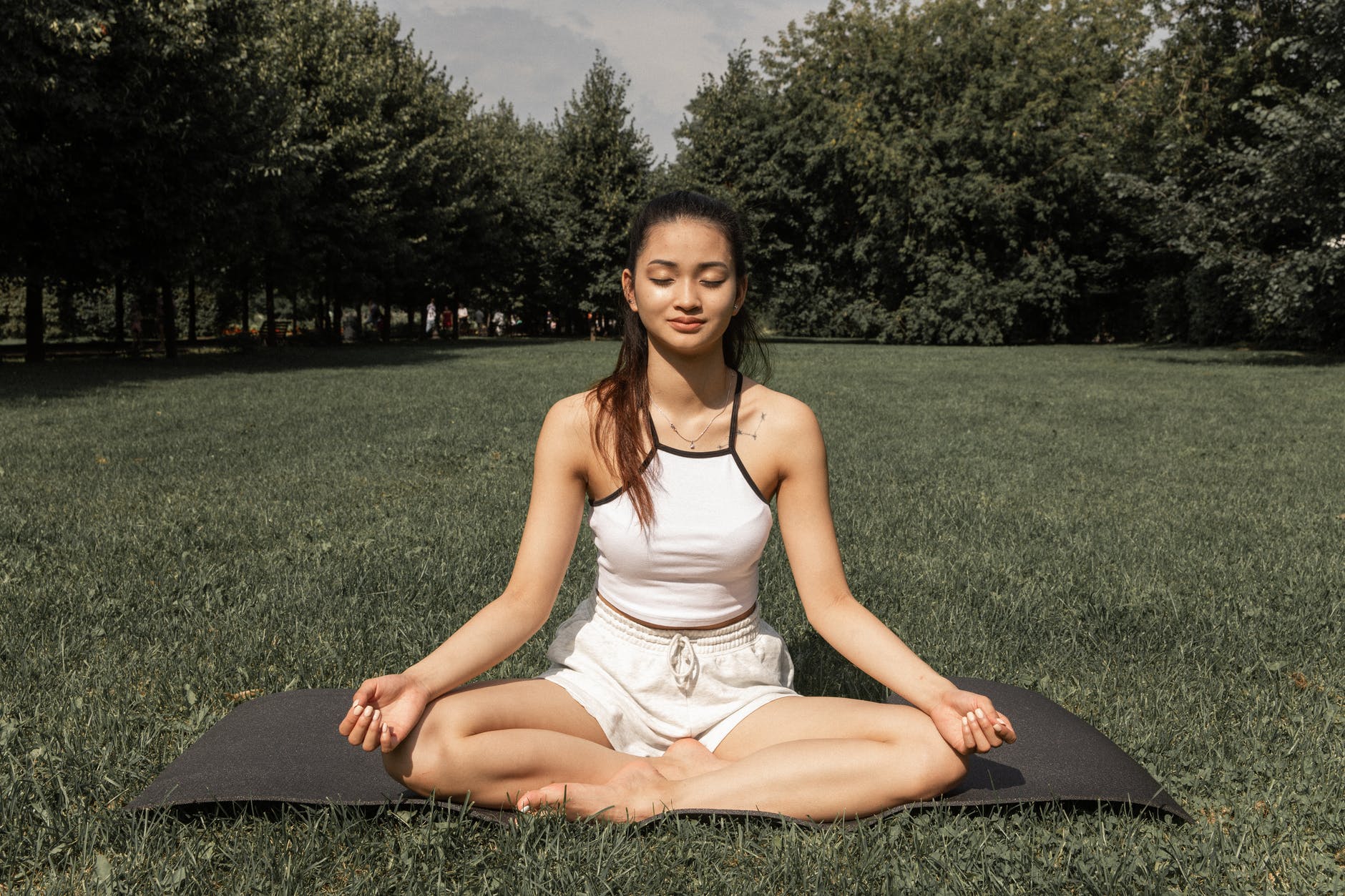Our everyday lives are not less than a battleground. It is filled with endless tasks at home and work, balancing friends, family and career, and dealing with mental and emotional stress. All this often makes us feel overwhelmed, burned out, and at times hopeless and depressed.
All this makes us feel cluttered, so one should try meditation to de-clutter one’s life and mind.
What is meditation?
The meaning of meditation has been described by many in many different ways.
The famous definition by Swami Vivekananda that meditation is `thinking of God with the help of a mantra` explains that it is mainly a process where one focuses their mind on a single idea. It can be anything from focusing on breathing to chanting a prayer or repeating a mantra (words that are used in meditation).
While others describe it in ways other than that, like to train the mind to be more attentive or teach it to be calm and be more compassionate.
Whereas, Manduka and Szmigiel have described meditation to be the art of living with full awareness.
But all in all, it can be said that with meditation, you are trying to train your mind a certain way and establish some order in it, either by silencing your thoughts or letting them pass through without any judgment.
History of meditation
Beforelooking further into the how and why of meditation, let’s take a sneak peek at its history and understand it a bit better.
Meditation has its roots thousands of years back. It is said that one of the earliest texts on meditation was written by Patanjali around 2000 BC. He was a philosopher who lived in India and was involved in writing down sutras (aphorisms) which were passed through oral teachings for thousands of years.
It also features in other eastern philosophies such as Buddhism, Taoism and Hinduism. They all have their variations of meditation techniques but the objective is always the same – To reach a state of complete peace or bliss by silencing your thoughts or accepting them without judging them.
Meditation has played a vital role in ancient times by helping people achieve a certain mental harmony with themselves and their surroundings.
And then we think about how it has found such widespread following in the west. So this is how it happened…
Meditation made its first appearance in the west with Dr. Richard Alpert (Ram Dass) and Timothy Leary, who visited India for the first time during their Harvard days. There they learned about meditation and started practicing it religiously as a part of Transcendental Meditation (TM). Transcendental meditation is focusing your mind by repeatedly iterating a mantra.
The winds of meditation spread globally during the late 1960s when LSD and other’ mind expanding’ drugs were popular. It was Leary who brought Transcendental Meditation to the west through his book ‘The Mucal,’ published in 1964, where he introduced it as an alternative way of thinking about things, a kind of spiritual exercise.
But that is not all that is there to meditation. It also includes practices like yoga, tai chi and qigong. Nowadays, you can find various meditation techniques available according to your local community and personal preference.
But is there any scientific evidence supporting the use of meditation as an effective treatment? Can it make a difference in our lives? Find out in the next section.
Why Meditate? (aka the benefits of meditation)
There are many benefits to meditation, including:
1. Increased Focus and Concentration:
Meditation improves your ability to focus by quieting the mind and reducing distractions. This is especially helpful in stressful times when every distraction matters!
2. Reduced Stress, Anxiety and Depression:
Evidence suggests that meditation can alter brain chemistry, making it easier to manage stress, anxiety and depression. People suffering from clinical depression usually have increased levels of cortisol and adrenaline. By controlling these hormones with meditation, it’s possible to decrease stress and increase positive feelings.
3. Increased Energy and Happier Moods:
Practicing Transcendental Meditation is said to provide a long-lasting source of energy by balancing the nervous system. It also helps prevent depression and negative mood swings.
4. Helps in increasing one’s imagination and creativity:
This is crucial for people who are tired of working with the same old ideas. For example, artists will benefit from this because they can now create their own visual effects without being bothered by negative thoughts and images. Meditation improves creativity because it encourages more random pattern thinking.
5. Reduces slow-wave sleep:
Though some may argue that meditation reduces REM sleep, the overall amount of slow-wave sleep actually increases with TM practice. This is good for people who have insomnia and need to replenish their energy supply before going back to work. Additionally, this may also be beneficial for senior citizens because it can help reduce their risk of suffering through a stroke or heart attack due to poor sleep quality.
6. Increases Self-Awareness:
Meditation helps in improving one’s self-awareness by focusing on breathing, emotions, thoughts and body sensations. This allows people to be aware of their feelings as they experience various situations, which can further help develop self-control over their behavior.
7. Helps in Weight Loss:
The hormone cortisol is known to trigger hunger pangs and overeating. When stress levels are high, people usually tend to crave unhealthy foods due to excess cortisol production. However, meditation has been proven to help reduce cortisol production, thus resulting in weight loss.
8. Helps balance overall human physiology:
Meditation is beneficial for the overall human body’s functioning as it helps balance the nervous system. The autonomic nervous system responsible for functions like digestion, heart rate, breathing and more, gets unbalanced in some people due to external stress factors.
9. Gain an overall balanced perspective in life and fight stressful situations:
Meditation helps people gain a new outlook towards life. It enables you to fight every stressful situation and the sensation proves helpful in overcoming issues that seemed unmanageable before meditation.
Types of meditation
You can choose your ideal type from many different types practised around the world, depending upon what suits you the best or what intrigues you the most. Here is a list of various forms of meditation that are popularly practiced to help you get started:
1. Zen meditation:
Practiced by Buddhists, this type of mediation involves using a kyosaku/keisaku (a wooden or plastic stick used to track your count in a group setting). This type of practice helps de-clutter the mind from thoughts and emotions detrimental to achieving a meditative state.
2. Qigong meditation:
Qi (pronounced as ‘chi’ or ‘chee’) is the elemental energy in the universe that can be harnessed by different methods or techniques. Qigong, a form of traditional Chinese medicine, involves movements (exercises), breathing control, physical exercises for health, self-massage and meditation to achieve a higher level of healing.
3. Vipassana mediation:
This ancient Indian/Buddhist meditation technique is used for enhancing mindfulness and means “seeing things as they really are” in the ancient language called Pali. This skill of being mindful is used to develop awareness, understanding and kindness.
4. Tai Chi meditation:
This technique of meditation originated in China and focuses on the balance of Yin and Yang. As a result, it is said to be capable of relieving stress or anxiety by increasing energy flow throughout the body by practicing some gentle movements and meditation.
5. Meditation with music:
This technique involves using a particular type of music called brainwave entrainment (BWE), an assisted form of meditation. BWE uses sounds from our surroundings to influence brainwaves and alter moods and states of awareness, for example, using binaural beats, which is a combination of two different beats of slightly differing frequencies which results in a third sound. Whenever the difference between the frequency of these two tones reaches your brain, they “entrain” or synchronize different areas of the brain that ordinarily fire at different frequencies.
6. Meditation in Nature:
This type of meditation is good for concentrating on basic concepts such as peace, contentment and inspiration. It assists in cleansing the mind and eliminating clutter from it so that you can be refreshed for a fresh start!
7. Chakra meditation:
Each of the seven primary chakra is situated at a different level in the body. These govern different human states and if they are imbalanced, then one faces issues related to that particular chakra.
8. Mantra Meditation:
A mantra is a special sound, word or phrase that one concentrates on to reach the stillness of mind. It can be any mantra you want, like the OM! You must repeat it in your mind and visualize its meaning.
9. Trataka (eye gazing):
This is one of the oldest forms of meditation used by people in India, and it’s now gaining worldwide popularity. In this, you gaze at an object such as a candle or a lit incense stick for 10-15 mins.
The other forms of meditation not briefed here but still widely practised are:
– Mindfulness Meditation
– Guided Meditation
– Visualization Meditation
– Vipassana or insight meditation.
So, this was a quick guide to the what and how of the meditation that we prepared for you. Yet meditation is a very vast discipline in itself and very personal to whoever tries it. So get into it, try it for yourself and reap the benefits of this beautiful, peaceful practice called meditation.
And if you are not keen on full-fledged meditation, you can try introspection, another important mental practice. One must constantly be aware of their nature, thoughts and feelings during the day to get a better hold on them. Sometimes our many troubles can be solved just by reflecting on our actions, thoughts or emotions or just simply going over the situation we are in.
Yoga is another practice that can be used to calm the mind and body. It also helps in preparation for meditation. Meditation practices like pranayama, Kriya as well as kundalini yoga are great ways to reform oneself.
Our body is like a machine and needs maintenance. So heed to the demands of your body and mind and do what it takes to get it to its optimum level. Never forget, our body and mind is our first and true home. You reside in it full time. Take time to de-clutter it, clean it, air it out, and make it the best place for yourself to live in and also the best tool to live life through.




